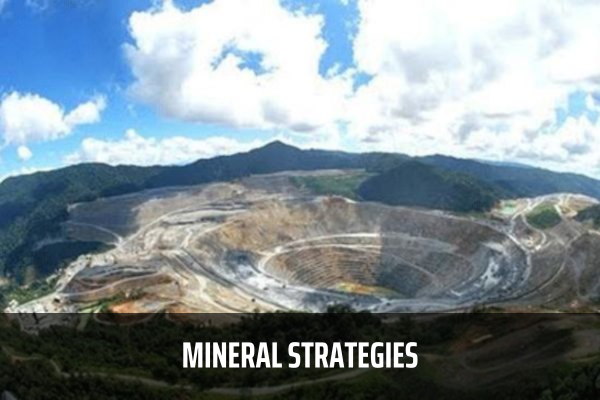What are the principles and contents of mineral strategies in Vietnam? What are the specific objectives for the Geology, Minerals, and Mining Industry Strategy in Vietnam?
What are the principles and contents of mineral strategies in Vietnam?
Pursuant to Article 9 of the Law on Mineral 2010 as amended by Clause 3, Article 8 of the Law on amendments to some articles concerning planning of 37 Laws in 2018, the principles and contents of mineral strategies are prescribed as follows. :
(1) Mineral strategies shall be elaborated on the following principles and bases:
- Conform to the socio - economic development, national defense and security strategy and plan and national comprehensive planning;
- Satisfaction of mineral needs for sustainable socio-economic development; and economical and wasteful exploitation and utilization of minerals;
- Domestic mineral demand and supply capacity and possibilities of international cooperation in the mining sector for socio-economic development:
- Available results of geological baseline surveys of minerals; and mineral-related geological prerequisites and signs.
(2) A mineral strategy must contain the following principal contents:
- Guiding viewpoints and objectives of geological baseline surveys of minerals, protection of unexploited minerals, mineral exploration, mining, processing and rational and economical utilization of minerals;
- Orientations for geological baseline surveys of minerals, protection of unexploited minerals, exploration and mining of each group of minerals, and post-mining processing and rational and economical utilization of minerals in the strategy's period;
- Major tasks and solutions in geological baseline surveys of minerals, protection of unexploited minerals, exploration and mining of each group of minerals, post-mining processing and rational and economical utilization of minerals; and national mineral reserves.
Mineral strategies shall be elaborated for 10-year periods, with a 20-year vision, corresponding to the period of relevant socio-economic development strategies
The Ministry of Natural Resources and Environment shall assume the prime responsibility for, and coordinate with the Ministry of Industry and Trade, the Ministry of Construction, the Ministry of Planning and Investment, other ministries and ministerial-level agencies and concerned localities in, elaborating mineral strategies for submission to the Prime Minister for approval.

What are the principles and contents of mineral strategies in Vietnam? What are the specific objectives for the Geology, Minerals, and Mining Industry Strategy in Vietnam? (Image from the Internet)
What are the specific objectives for the Geology, Minerals, and Mining Industry Strategy in Vietnam?
Pursuant to the spirit of subsection 2, Section II of Resolution 10-NQ/TW in 2022, the strategic orientation for geology, minerals, and mining industry until 2030, with a vision towards 2045, includes the following specific objectives for the Geology, Minerals, and Mining Industry Strategy:
By 2025, complete the mapping of mineral geology at a scale of 1:50,000, covering 80% of the land area. Conduct surveys and assessments of mineral resources in promising areas in the Northwest and Central Highlands regions. Conduct geological and mineral surveys at a scale of 1:500,000 in selected offshore areas up to depths of 300 and 1,500 meters. Explore, exploit, and process certain minerals to reach regional standards and approach international standards.
By 2030, complete the mapping of mineral geology at a scale of 1:50,000, covering 85% of the land area.
Conduct surveys and assessments of energy and metal mineral resources in promising areas in the North Central Coast and South Central Coast regions. Conduct surveys on landslide and flood-prone areas in mountainous provinces. Conduct geological and environmental mapping in areas containing hazardous and radioactive minerals. Identify favorable geological structures for the application of carbon burial and disposal of other hazardous substances.
Establish a comprehensive database and information system on geology and minerals, integrated with the national database. Explore, exploit, and process most minerals to reach regional standards and approach international standards.
What are the procedures for developing the Geology, Minerals, and Mining Industry Strategy in Vietnam?
Pursuant to subsection 1 of Section A, Part II in the Appendix of the List of Internal Administrative Procedures in the field of geology and minerals within the state administrative system under the management function of the Ministry of Natural Resources and Environment, issued with Decision 1082/QD-BTNMT in 2024, the procedures for developing the Geology, Minerals, and Mining Industry Strategy (referred to as the Strategy) are as follows:
(1) Implementation sequence:
- Step 1: The Ministry of Natural Resources and Environment takes the lead in coordinating with the Ministry of Industry and Trade, the Ministry of Construction, the Ministry of Planning and Investment, other relevant ministries, agencies, and localities to summarize and evaluate the results of the previous phase of the Strategy.
- Step 2: The Ministry of Natural Resources and Environment submits a draft of the next phase of the Strategy to solicit opinions from relevant ministries, sectors, and localities through written communication.
- Step 3: Refine the draft Strategy based on the feedback and submit it for approval by the Prime Minister.
- Step 4: The Prime Minister signs the Decision to approve the Strategy.
(2) Implementation method: Not specified.
(3) Document requirements: Not specified.
(4) Implementation timeframe: Not specified.
(5) Authority responsible for the administrative procedure: Ministry of Natural Resources and Environment.
(6) Authority resolving the administrative procedure: Prime Minister.
(7) Result of the administrative procedure: Approval Decision by the Prime Minister.
(8) Fees (if applicable): Not specified.
(9) Application form, declaration form: Not specified.
(10) Requirements and conditions for the administrative procedure (if applicable): Not specified.
LawNet